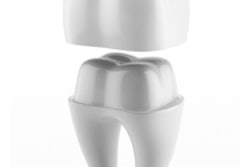
A study of 1,335 all-ceramic restorations placed between 1987 and 2009 has found that they are both predictable and reliably successful, with a 93.5% probability of survival over a 10-year period (International Journal of Prosthodontics, January/February 2012, Vol. 25:1, pp. 70-78).
Only glass ceramic restorations placed between 1987 and 2009 were evaluated in the study, which was conducted by members of the clinical department of restorative and prosthetic dentistry at Medical University Innsbruck.
Cases involving bruxism, nonvital teeth, and specific cementation agents created significantly increased rates of failure. Yet even when failures occurred, patients overwhelmingly reported "excellent" satisfaction.
"The purpose of this clinical retrospective study was to evaluate the clinical quality, success rate, and estimated survival rate of silicate glass-ceramic restorations in both dental arches over a 20-year period," the authors wrote. They also examined patient- and restoration-specific variables to see which could predict a ceramic restoration failure.
Study methodology
A total of 302 patients (120 men and 182 women) participated in the study. They were examined at the university during regularly scheduled visits for maintenance. Patient-specific data about sex, age, tooth sensitivity, smoking, and bruxism were noted, as well as self-reported data regarding their level of satisfaction with their restorations: excellent, good, medium, or none. The restorations were categorized by region as well, into anterior, premolar, and molar regions.
All 1,335 silicate ceramic restorations had been placed at the university between November 1987 and December 2009. Of these restorations, 451 were observed over a 10-year period, 84 for 15 years, and 24 over 20 years.
Clinical examinations were carried out by two dentists between March and July of 2010. One dentist had placed most of the restorations, whereas the other had placed none of them. California Dental Association/Ryge criteria were used to rate each ceramic restoration as a success if it received an alpha or bravo grade, or as a failure if it received a charlie or delta grade.
Any restorations that had severe enough issues to necessitate replacement were deemed an absolute failure. If a finishing procedure or polishing could correct the issue, the restoration was labeled a relative failure.
Survival rates
Only 95 restorations were rated as failures, 79% of which were absolute. Most failures occurred in the anterior region, with 65, while 19 occurred in premolars and 11 occurred in molars.
Success rates remained strong over time. The estimated survival rate was 97.3% at five years, 96% at eight years, 94% at 10 years, 85.8% at 15 years, and 78.5% after 20 years. Nearly half of the failures occurred in the first eight years, the researchers noted.
While the entire study included 1,335 all-ceramic restorations, 69 failures took place prior to the 2010 examination, so 1,266 were considered. Of these, 26 were rated not acceptable and unsatisfactory when evaluated.
The most frequent reason for failure was fracture of the ceramic, according to the researchers, followed in order by cracks in the ceramic and secondary caries.
Interestingly, "comparing the type of restoration and all-ceramic material as a predictor for failure, no significant differences were found," they added.
Nonvital teeth and patients with bruxism displayed significantly higher failure rates (p < 0.0001 and p = 0.0045, respectively). The choice of luting agent also was relevant. Cementation using Variolink (Ivoclar Vivadent) showed significantly fewer failures than Optec cement (Pentron, p = 0.0217) and Dual cement (Ivoclar Vivadent, p = 0.0099), the researchers noted.
Patient satisfaction
Patient responses to questions about satisfaction were quite positive, with 96% rating it as "excellent" and 4% rating it as "good." Not a single respondent rated his or her satisfaction as "medium" or "none."
"All of the patients, even those who had ceramic failures, regarded the all-ceramic restorations as an ideal type of dental restoration and would bear the time and costs of the all-ceramic procedure again," the researchers wrote.
However, because of the higher occlusal forces present in molar teeth, "the dentist has to be especially careful of ceramic material selection depending on indication, the extent of the defect, and the patient," they added.



















